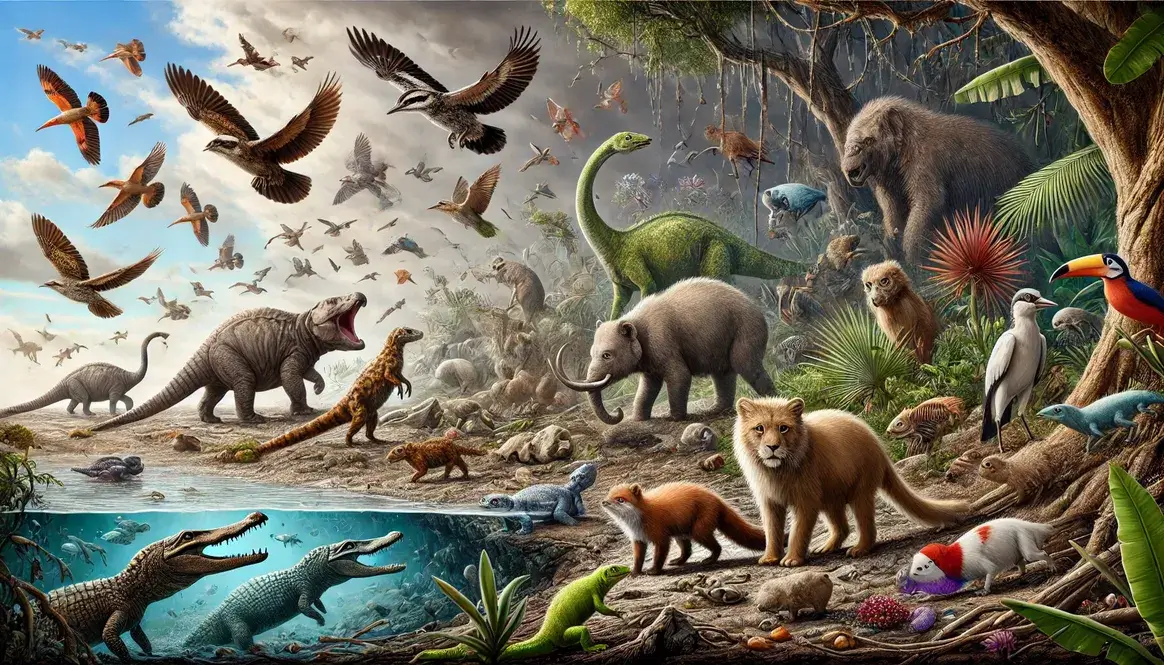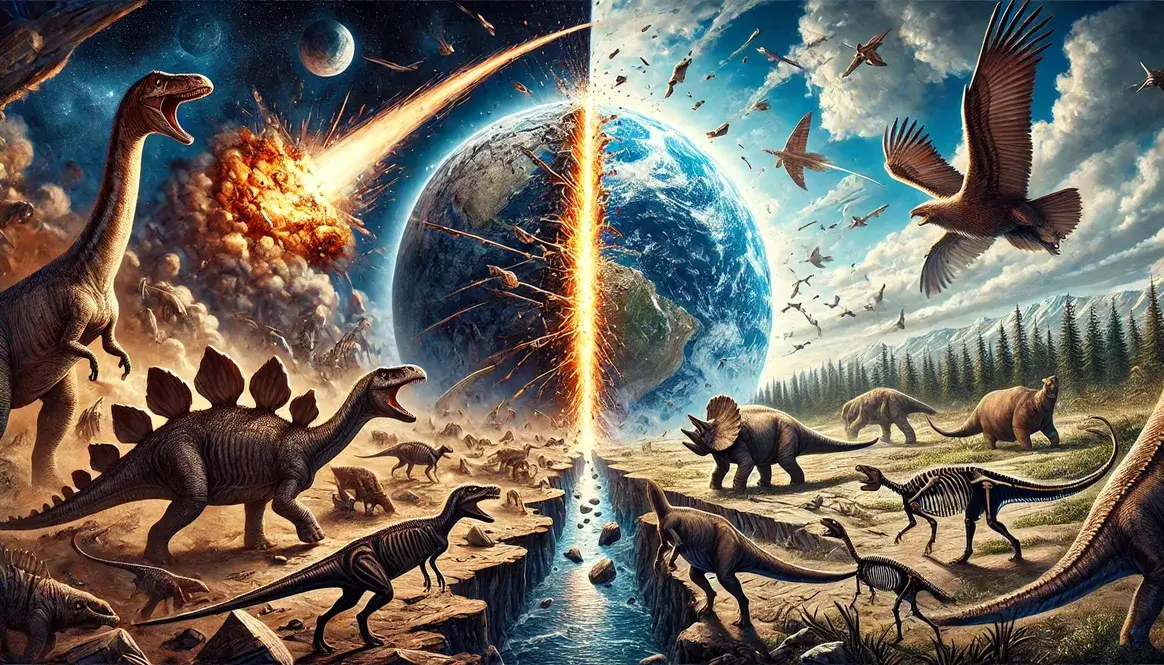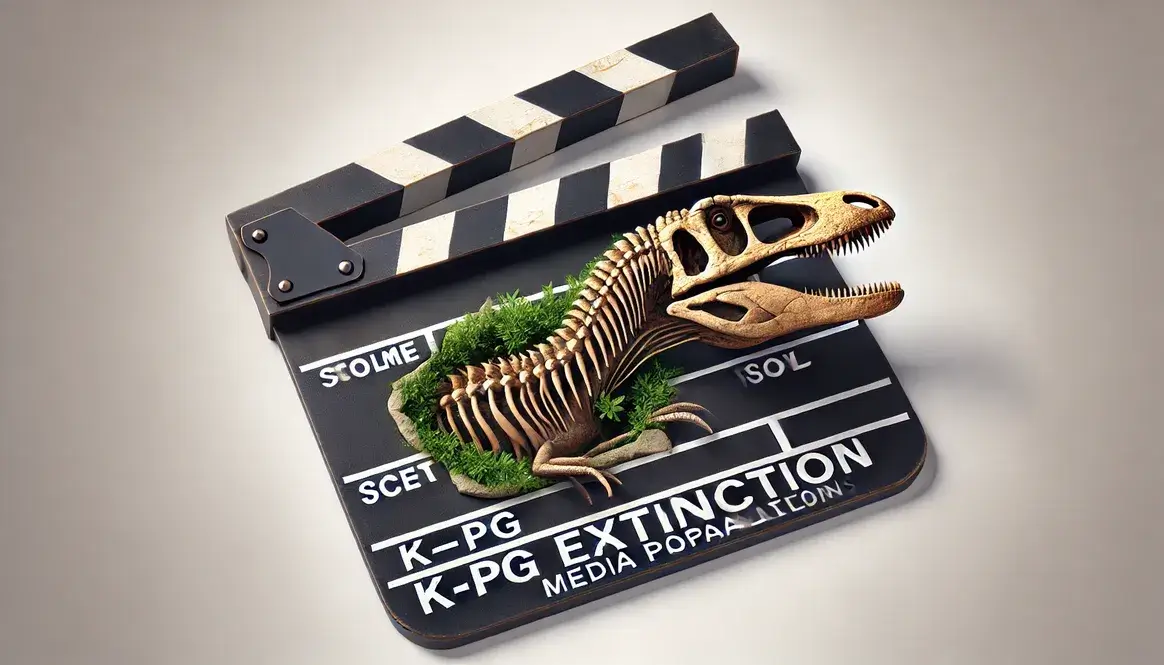The K-Pg extinction event, which took place about 66 million years ago, wiped out around 75% of plant and animal species on Earth. But not everything vanished. Some creatures managed to survive this catastrophic event, paving the way for the diverse world we see today. Let’s explore the major groups that made it through this tough time.
So what survived the K-Pg extinction event?
Mammals
Tiny, furry creatures scurrying in the shadows of dinosaurs turned out to be some of the toughest survivors of the K-Pg extinction. These early mammals had a few tricks up their sleeves that helped them pull through:
- Size matters: Most mammals at the time were small, about the size of mice or shrews. Their tiny bodies needed less food and could hide more easily.
- Night owls: Many were nocturnal, which may have protected them from the worst effects of the impact.
- Burrowing behavior: Some mammals could dig underground, finding shelter from harsh conditions.
Examples of early mammal survivors include:
| Mammal Type | Description | Key Survival Trait |
|---|---|---|
| Multituberculates | Rodent-like mammals with complex teeth | Diverse diet, could eat seeds and insects |
| Metatherians | Early marsupial relatives | Possibly able to enter a state of dormancy |
| Placentals | Ancestors of most modern mammals | Adaptable to various environments |
These small, hardy creatures laid the groundwork for the explosion of mammal diversity that followed in the next few million years.
Birds
Birds, believe it or not, are living dinosaurs! They’re the only dinosaur group that survived the K-Pg extinction. But why did these feathered friends make it when their bigger relatives didn’t?
Characteristics that helped birds survive:
- Flight: The ability to fly likely helped birds escape local disasters and find new food sources.
- Small size: Like mammals, many birds were relatively small, needing less food to survive.
- Diverse diets: Birds that could eat a variety of foods, including seeds, had a better chance of finding sustenance.
- Toothless beaks: Birds with beaks could crack open seeds, a food source that was more readily available after the extinction event.
Birds that made it through were likely the ancestors of modern ground-dwelling birds like chickens and ducks. These survivors set the stage for the incredible variety of birds we see today, from tiny hummingbirds to majestic eagles.
The survival of these groups shows how adaptability and certain key traits can make all the difference when facing major environmental changes. In the next sections, we’ll explore more survivors and dive deeper into what made them so resilient.
Reptiles
Among the survivors of the K-Pg extinction were several groups of reptiles. Crocodilians, turtles, and some lizards managed to weather the storm, adapting to the changing world around them.
Crocodilians: These ancient creatures have been around for over 200 million years, surviving multiple mass extinctions. Their success during the K-Pg event can be attributed to several factors:
- Ability to remain underwater for long periods
- Cold-blooded metabolism allowing them to go without food for extended times
- Diverse diet including fish, carrion, and small prey
Turtles also proved to be surprisingly resilient. Their hard shells provided protection, while their ability to survive in various habitats helped them adapt to the changing environment.
Lizards that survived were mostly small, insect-eating species. Their size and dietary flexibility likely played a crucial role in their survival.
Amphibians
Frogs, salamanders, and other amphibians demonstrated remarkable resilience during the K-Pg extinction. These water-loving creatures had several advantages that helped them pull through:
- Aquatic habitats: Many amphibians lived in freshwater environments, which were less affected by the immediate impact of the extinction event.
- Hibernation: Some species could enter a state of dormancy, allowing them to survive periods of extreme conditions.
- Rapid reproduction: Amphibians can produce large numbers of offspring quickly, helping their populations recover.
- Adaptable diets: Many amphibians can eat a variety of small prey, including insects that also survived the extinction.
Interestingly, the ancestors of modern frogs seemed to have fared better than other amphibian groups. This may be due to their unique jumping ability, which could have helped them escape predators and find new habitats more easily.
| Amphibian Group | Key Survival Traits |
|---|---|
| Frogs | Jumping ability, diverse habitats |
| Salamanders | Ability to regenerate limbs, varied diets |
| Caecilians | Burrowing behavior, streamlined bodies |
The survival of these amphibians played a crucial role in shaping the biodiversity we see today. Their persistence through the K-Pg extinction event allowed them to evolve and diversify, filling ecological niches left vacant by extinct species.
Fish
The K-Pg extinction event hit marine ecosystems hard, but many fish species managed to survive. Both marine and freshwater fish showed remarkable resilience, with their aquatic habitats serving as crucial refuges.
Marine fish that made it through the catastrophe included:
- Sharks and rays
- Teleost fish (ancestors of most modern bony fish)
- Lungfish
Freshwater environments provided a buffer against some of the worst effects of the extinction event. Lakes and rivers experienced less severe temperature fluctuations and had a more stable food supply compared to marine environments. This allowed many freshwater fish species to persist, including:
- Gars
- Bowfins
- Certain species of catfish
The survival of these fish was crucial for the recovery of ecosystems after the extinction event. They served as important food sources for other surviving animals and helped maintain the balance in aquatic food webs.
Invertebrates
Tiny but tough, many invertebrates survived the K-Pg extinction, showcasing a wide array of survival strategies. These small creatures played a vital role in preserving biodiversity and helping ecosystems recover.
Insects: Many insect species made it through the extinction event. Their success can be attributed to:
- Short life cycles and rapid reproduction
- Ability to eat a variety of foods
- Small size, allowing them to hide in protected microhabitats
Beetles, in particular, showed remarkable resilience. Their hard exoskeletons and diverse diets helped them weather the challenging conditions.
Mollusks: While many marine mollusks were hit hard by the extinction, some groups persisted. Freshwater mollusks, like snails and mussels, fared better than their marine counterparts. Their ability to filter feed and survive in various water conditions contributed to their survival.
Other invertebrate survivors included:
| Invertebrate Group | Survival Strategy |
|---|---|
| Cockroaches | Generalist diet, hardy nature |
| Arachnids | Diverse habitats, predatory skills |
| Worms | Burrowing behavior, simple needs |
These invertebrates’ survival was crucial for the post-extinction world. They served as food sources for other animals and played essential roles in nutrient cycling and pollination.
One fascinating example is the survival of certain ancient ocean creatures, like horseshoe crabs. These “living fossils” have remained relatively unchanged for millions of years, showcasing the incredible resilience of some invertebrate species.
The diverse survival strategies of these small creatures highlight the importance of adaptability in the face of environmental changes. Their persistence through the K-Pg extinction event set the stage for the rich invertebrate biodiversity we see in today’s world.
Plants
The K-Pg extinction wasn’t just about animals; plants played a crucial role in the survival and recovery of ecosystems. Seed-bearing plants, in particular, showed remarkable resilience during this tumultuous time.
Survivors among the flora:
- Ferns
- Conifers (like pines and cypresses)
- Early flowering plants (angiosperms)
Ferns, with their ability to reproduce via spores, were among the first plants to bounce back after the extinction event. Their rapid growth and adaptability allowed them to quickly colonize areas devastated by the impact.
Conifers, already well-established before the extinction, managed to persist through the crisis. Their tough needles and ability to withstand harsh conditions served them well during the challenging post-impact years.
Flowering plants, though relatively new on the scene, also survived the extinction. Their diverse reproductive strategies and ability to form mutually beneficial relationships with insects gave them an edge in the changing environment.
The survival of these plants was crucial for the recovery of entire ecosystems. They provided food and habitat for surviving animals, helping to kickstart the process of ecological renewal. As plant diversity increased, it paved the way for the evolution and diversification of new animal species, shaping the post-extinction world.
Survival characteristics
What made some creatures survive while others perished? Let’s examine the common traits shared by many K-Pg survivors.
Size advantages
When it comes to surviving mass extinctions, sometimes less is more. Smaller animals often had better chances of making it through the K-Pg event. But why?
- Lower food requirements: Smaller bodies need less fuel, making it easier to survive when food is scarce.
- More hiding spots: Tiny creatures could take shelter in small spaces, protecting them from harsh conditions.
- Faster reproduction: Many small animals can produce offspring quickly, helping populations recover.
- Adaptability: Smaller species often adapt more easily to changing environments.
Examples of size-related survival can be seen across various groups:
| Animal Group | Small Survivors | Larger Relatives (Extinct) |
|---|---|---|
| Mammals | Rat-sized insectivores | Large multituberculates |
| Birds | Chicken-sized ground birds | Larger flying birds |
| Reptiles | Small lizards | Giant marine reptiles |
It’s important to note that while being small was generally advantageous, it wasn’t a guarantee of survival. Other factors, such as habitat and diet, also played crucial roles.
Interestingly, this size advantage pattern isn’t unique to the K-Pg extinction. Similar trends have been observed in other mass extinction events, suggesting that being small can be a powerful survival strategy during times of global crisis.
Habitat flexibility
When the world turned upside down during the K-Pg extinction, creatures that could adapt to changing environments had a leg up on survival. This ability to thrive in various habitats proved crucial as the familiar landscapes of the late Cretaceous were dramatically altered.
Generalist species, those able to live in multiple types of environments, fared much better than their specialist counterparts. These adaptable animals could move between different habitats as conditions changed, increasing their chances of finding food, shelter, and mates.
Consider the early mammals that survived:
- They could live both on the ground and in trees
- Many were able to burrow, providing shelter from extreme conditions
- Some could swim, accessing aquatic food sources
This flexibility allowed them to exploit new niches left vacant by extinct species, setting the stage for their later diversification.
In contrast, highly specialized creatures often struggled. For example, many marine reptiles that were perfectly adapted to life in the late Cretaceous seas couldn’t cope with rapidly changing ocean conditions and went extinct.
Dietary adaptability
When it comes to survival, being a picky eater can be a major disadvantage. The K-Pg extinction event severely disrupted food chains, and animals with varied or flexible diets had a clear edge.
Omnivores and scavengers were particularly well-positioned to survive:
- Omnivores: Could switch between plant and animal food sources as availability changed
- Scavengers: Able to feed on carrion, which was likely plentiful in the aftermath of the extinction
Let’s look at some examples:
| Animal Type | Dietary Adaptability | Example |
|---|---|---|
| Mammals | Omnivorous | Early primates |
| Birds | Varied diets | Ancestors of modern fowl |
| Reptiles | Opportunistic feeders | Crocodilians |
These flexible eaters could take advantage of whatever food sources were available, whether it was seeds, insects, small prey, or decaying organic matter.
In contrast, specialist feeders often struggled. Many large herbivorous dinosaurs, for instance, were dependent on specific plant types. When these plants became scarce or extinct, these dinosaurs couldn’t adapt their diets quickly enough to survive.
The ability to eat a variety of foods wasn’t just about immediate survival. It also allowed these animals to persist through the challenging years following the extinction event, as ecosystems slowly recovered and new food sources became available.
Interestingly, this dietary flexibility also played a role in the evolution of new species. As survivors adapted to new food sources, they developed new physical features and behaviors, leading to the diverse array of animals we see today. From the tiny mammals that could eat both insects and seeds to the resilient crocodilians that could hunt or scavenge as needed, dietary adaptability proved to be a key factor in determining what survived the K-Pg extinction.
Hibernation and dormancy
The ability to enter a state of hibernation or dormancy proved to be a life-saving trait for many species during the K-Pg extinction event. This remarkable adaptation allowed animals to essentially “sit out” the worst of the environmental upheaval.
Species with dormancy abilities:
- Certain mammals (early hibernators)
- Some reptiles and amphibians (brumation)
- Various insects (diapause)
- Seeds of many plant species
These creatures could lower their metabolic rates dramatically, reducing their need for food and water. This trait was particularly advantageous given the scarcity of resources in the post-impact world.
For example, early mammals that could enter torpor (a state of decreased physiological activity) might have been able to survive extended periods of cold and darkness by slowing their bodily functions and conserving energy. Similarly, amphibians could burrow into mud and remain dormant until conditions improved.
Plants, too, benefited from dormancy. Seeds that could remain viable in the soil for long periods were able to sprout when conditions became favorable again, helping to re-establish plant communities.
This ability to “wait out” harsh conditions played a crucial role in the survival of many species, allowing them to persist through the immediate aftermath of the extinction event and into the recovery period that followed.
Survival mechanisms
The K-Pg extinction event was a true test of survival, and different species employed various strategies to make it through. Let’s explore some of the theories on how they managed to survive.
Underground refuge
When the sky was falling (quite literally, in the case of the asteroid impact), the safest place to be was underground. Burrowing animals had a significant advantage during the K-Pg extinction, and here’s why:
- Protection from immediate impact: Subterranean habitats shielded animals from the initial blast and heat wave.
- Insulation from temperature changes: Underground spaces maintained more stable temperatures compared to the surface.
- Access to food sources: Many burrowers fed on roots, fungi, and soil invertebrates, which were less affected by surface conditions.
- Shelter from predators: In a time of scarcity, being hidden underground provided safety from desperate predators.
Examples of burrowing survivors include:
| Animal Group | Burrowing Survivors | Survival Advantage |
|---|---|---|
| Mammals | Early rodent-like animals | Could dig deep burrows for long-term shelter |
| Reptiles | Certain lizards and snakes | Used existing burrows or could create their own |
| Amphibians | Salamanders and caecilians | Could burrow into moist soil or mud |
These underground havens weren’t just temporary shelters. For many species, they became long-term homes during the years of environmental instability that followed the impact. The ability to create or inhabit these subterranean refuges was a key factor in determining which species persisted through the extinction event.
Interestingly, this survival strategy has parallels in other mass extinctions throughout Earth’s history. The ability to retreat underground has repeatedly proven to be a valuable adaptation in times of global crisis, highlighting the importance of diverse survival mechanisms in the face of catastrophic events.
Aquatic havens
When the K-Pg extinction event turned the world upside down, water bodies became unexpected sanctuaries for many species. Both freshwater and marine environments offered unique advantages that helped various creatures survive the catastrophe.
Freshwater ecosystems, in particular, proved to be crucial survival zones:
- Temperature stability: Water’s high heat capacity helped maintain more consistent temperatures.
- Filtration effect: Water bodies filtered out some of the atmospheric dust and debris.
- Nutrient retention: Aquatic environments often held onto nutrients better than land.
Marine environments, while severely impacted, also provided refuge for certain species. Deep ocean habitats, for instance, were somewhat insulated from the immediate effects of the impact.
Why did water bodies offer better chances of survival?
- Buffering effect: Water acted as a buffer against rapid temperature changes and environmental fluctuations.
- Food availability: Aquatic food chains, while disrupted, often remained more intact than terrestrial ones.
- Oxygen supply: Dissolved oxygen in water remained available even when the atmosphere was choked with dust.
This aquatic advantage helped explain the survival of various groups, from resilient fish species to amphibians and certain reptiles. Even some land-dwelling animals that could swim or dive had an edge over their strictly terrestrial counterparts.
Seed and spore resilience
In the plant world, seeds and spores emerged as the unsung heroes of the K-Pg extinction event. These tiny packages of life demonstrated remarkable resilience in the face of global catastrophe.
How plant seeds and spores survived:
- Protective coatings: Many seeds and spores had tough outer layers that shielded them from harsh conditions.
- Dormancy mechanisms: The ability to remain viable but inactive for long periods helped them weather the worst of the extinction event.
- Wide dispersal: Seeds and spores spread over large areas increased the chances of some finding suitable conditions for growth.
Some seeds could remain dormant in the soil for years or even decades, waiting for the right conditions to sprout. This “seed bank” became a crucial reservoir of plant diversity during the recovery period.
The importance of dormant plant material in recovery cannot be overstated. As conditions began to improve, these seeds and spores were ready to spring into action, helping to re-establish plant communities and kickstart ecosystem recovery.
This plant resilience had far-reaching effects:
- Provided food for surviving herbivores
- Helped stabilize soils and prevent erosion
- Began the process of carbon sequestration, slowly helping to regulate the post-impact climate
The survival of these plant propagules laid the foundation for the diverse flora we see today. From the ferns that quickly colonized disturbed areas to the flowering plants that would go on to dominate many ecosystems, the resilience of seeds and spores played a pivotal role in shaping the post-extinction world.
Understanding this plant survival mechanism offers valuable insights into ecosystem resilience and recovery, lessons that remain relevant as we face modern environmental challenges.
Scavenging and opportunism
In the aftermath of the K-Pg extinction, the world was littered with the remains of countless creatures. For some animals, this grim scenario presented an unexpected opportunity. Scavengers and opportunistic feeders found themselves in a position to thrive amidst the devastation.
Animals that benefited from scavenging:
- Early mammals
- Certain bird species
- Crocodilians
- Some fish and shark species
These creatures adapted quickly to take advantage of the abundant carrion and detritus available in the post-extinction landscape. Their ability to consume a wide variety of food sources, including decaying matter, gave them a significant edge in survival.
Adaptable feeding strategies proved crucial during this time. Animals that could switch between different food sources or consume almost anything they came across were more likely to survive. For instance, early mammals that could eat both plant matter and carrion had access to a wider range of nutrients, increasing their chances of survival.
This opportunistic approach wasn’t just about immediate survival. It also played a role in shaping the evolution of species that would go on to dominate in the post-extinction world. The ability to scavenge and adapt to available food sources became a valuable trait, influencing the development of diverse feeding strategies in many modern animal groups.
Post-extinction recovery and diversification
After the dust settled from the K-Pg extinction event, the survivors faced a world of opportunity. Empty niches and reduced competition set the stage for an extraordinary period of evolution and diversification.
Rapid evolutionary radiation
The aftermath of the K-Pg extinction witnessed an explosion of new species from surviving lineages. This process, known as adaptive radiation, saw the rapid diversification of surviving groups to fill vacant ecological niches.
Key factors driving this rapid evolution included:
- Reduced competition
- Availability of new food sources
- Open habitats
- Changing environmental conditions
Examples of post-extinction adaptive radiation are numerous and fascinating:
| Animal Group | Adaptive Radiation Example |
|---|---|
| Mammals | Diversification into various ecological roles, from small insectivores to large herbivores |
| Birds | Evolution of diverse beak shapes to exploit different food sources |
| Bony fish | Rapid speciation to fill various marine and freshwater niches |
One of the most striking examples is the evolution of mammals. From small, mostly nocturnal creatures, mammals rapidly diversified into a wide array of forms. This includes the ancestors of modern groups like primates, rodents, and hoofed mammals.
Birds also underwent significant adaptive radiation. The surviving avian species quickly evolved into diverse forms, adapting to different habitats and food sources. This led to the evolution of many modern bird groups, from waterbirds to perching birds.
In the plant world, flowering plants (angiosperms) experienced a burst of diversification. They evolved new strategies for pollination and seed dispersal, leading to the wide variety of flowers and fruits we see today.
This period of rapid evolution reshaped the Earth’s ecosystems, laying the groundwork for the biodiversity we see in the modern world. It serves as a powerful example of life’s resilience and adaptability in the face of catastrophic change.
Filling ecological niches
The mass extinction at the end of the Cretaceous period left numerous ecological roles vacant. As the dust settled, surviving species found themselves in a world of new opportunities. This process of filling empty niches played a crucial role in shaping the modern biodiversity we see today.
Survivors adapted in remarkable ways to occupy the roles once held by extinct species:
- Mammals becoming large herbivores: With the disappearance of large dinosaurs, some mammal lineages evolved into bigger herbivores. This led to the emergence of animals like early elephants and rhinoceroses.
- Birds as apex predators: In the absence of large carnivorous dinosaurs, some bird species evolved into formidable predators. The terror birds of South America are a prime example of this adaptation.
- Bony fish diversification: With many marine reptiles gone, bony fish rapidly evolved to fill various roles in ocean ecosystems, from small reef-dwellers to large predators.
The post-extinction world offered a plethora of new opportunities for surviving species. Reduced competition and open habitats allowed for rapid adaptation and diversification. This period saw the emergence of new feeding strategies and behaviors as animals adapted to fill available niches.
For instance, some early primates developed grasping hands and enhanced vision, allowing them to exploit arboreal niches that were previously dominated by certain dinosaurs and pterosaurs. In the plant world, flowering plants capitalized on the extinction of many conifers and ferns, leading to an explosion of angiosperm diversity.
These adaptations weren’t limited to individual species. Entire ecosystems were reshaped as survivors evolved to interact in new ways. New predator-prey relationships emerged, and novel mutualistic associations formed between plants and animals.
The filling of ecological niches after the K-Pg extinction demonstrates the incredible adaptability of life. It shows how surviving species can evolve to take advantage of new opportunities, even in the wake of catastrophic events. This process of niche-filling and adaptation continues to influence evolution today, shaping how species respond to ongoing environmental changes.









